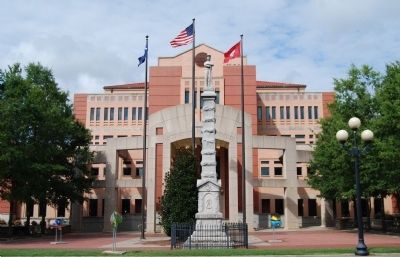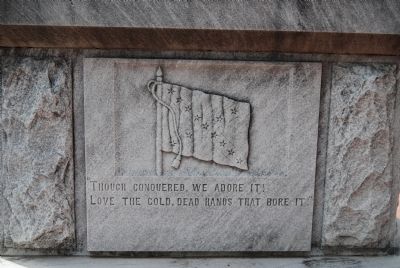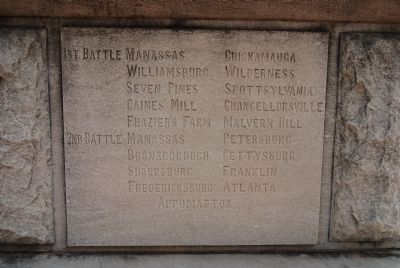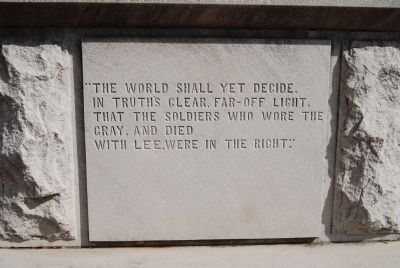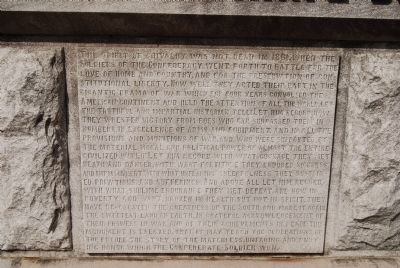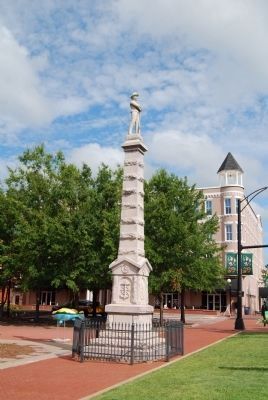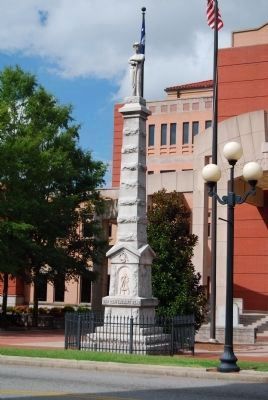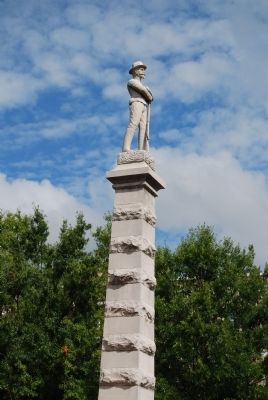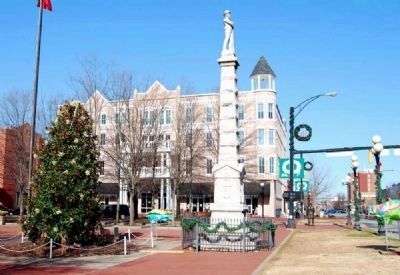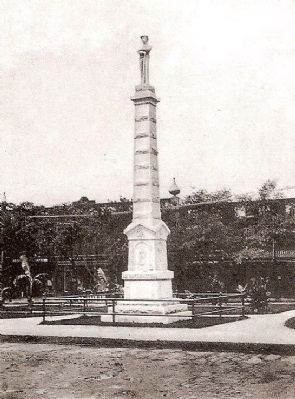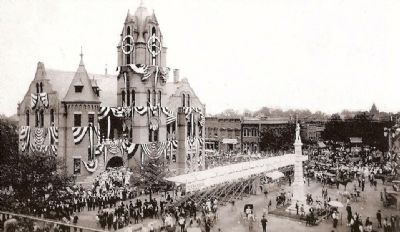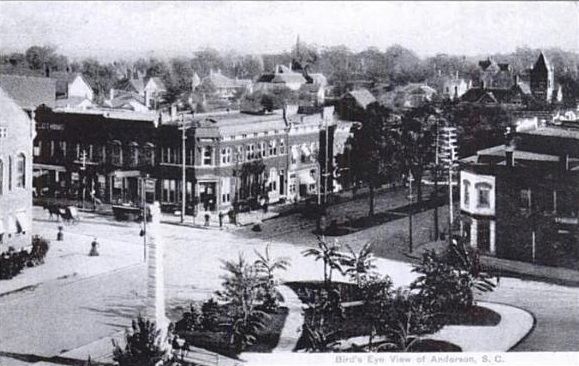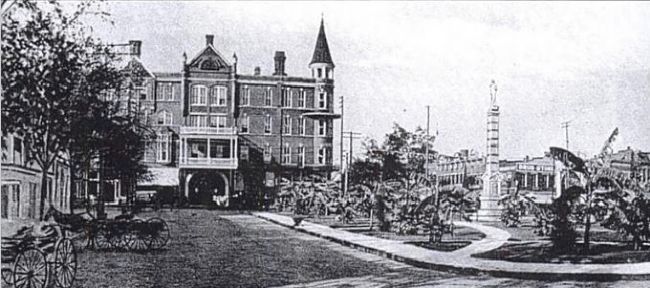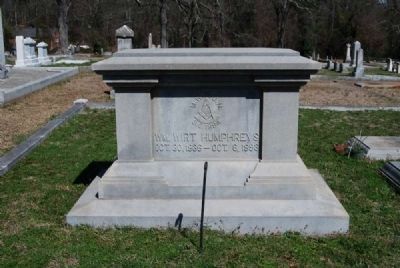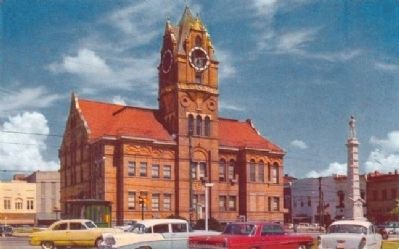Anderson in Anderson County, South Carolina — The American South (South Atlantic)
Anderson County Confederate Monument
Inscription.
[North]:
(Crossed swords in scabbards with a laurel wreath - representing the cavalry.)
(Confederate Battle Flag)
"Though conquered, we adore it!
Love the cold dead hands that bore it!"
[West]:
(Cannon wheel, cannon balls, cannon swabs - representing the artillery.)
1st Battle Manassas, Williamsburg, Seven Pines, Gaines' Mill, Frazier's Farm, Chickamauga, Wilderness, Spottsylvania, Chancellorsville, Malvern Hill.
2nd Battle Manassas, Boonsborough, Sharpsburg, Fredericksburg, Petersburg, Gettysburg, Franklin, Atlanta, Appomattox.
[South]:
(Unfurled stainless banner)
DC
61-65
(An anchor and a ship's wheel - representing the Navy.)
"The world shall yet decide,
in truth's clear, far-off light,
that the soldiers who wore the
gray, and died
with Lee, were in the right."
[East]:
(Three stacked bayonetted rifles with a laurel wreath, canteen, and cartridge pouch - representing the infantry.)
The spirit of chivalry was not dead in 1861, when the Soldiers of the Confederacy went forth to battle for the love of home and country, and for the preservation of constitutional liberty. How well they acted their parts in the gigantic drama of war which for four years convulsed the American continent and held the attention of all the world. Let the truthful and impartial historian tell! Let him record how they wrestled victory from foes who far surpassed them in numbers, in excellence of arms and equipment, and in all the provisions and munitions of war, and who supported by the material, moral, and political power of almost the entire civilized world. Let him record with what courage they met death and danger, with what fortitude they endured sickness and imprisonment, with what unflagging cheerfulness they sustained privations and suffering. And above all let him record with what sublime endurance they met defeat, and how in poverty and want, broken in health, but not in spirit, they have re-created the greatness of the south and made it again the sweetest land on earth. In grateful acknowledgement of their prowess in war, and of their achievements in peace, this monument is erected, that it may teach the generations of the future the story of the matchless, unfading, and undying honor which the Confederate Soldier won.
Erected 1902 by Citizens of Anderson County.
Topics. This historical marker and monument is listed in these topic lists: Military • War, US Civil. A significant historical year for this entry is 1861.
Location. 34° 30.189′ N, 82° 39.021′ W. Marker is in Anderson, South Carolina, in Anderson County. Marker is at the intersection of South Main Street (State Highway 28) and West Whitner Street (State Highway 24), on the right when traveling south on South Main Street. Marker is located directly in front of the New County Courthouse. It faces the Old County Courthouse. Touch for map. Marker is at or near this postal address: 100 South Main, Anderson SC 29621, United States of America. Touch for directions.
Other nearby markers. At least 8 other markers are within walking distance of this marker. Anderson County Law Enforcement Officers Memorial (a few steps from this marker); Anderson County Court House -- 1898 (a few steps from this marker); William Church Whitner (a few steps from this marker); Anderson: "The Electric City" (a few steps from this marker); The Four Way Test (within shouting distance of this marker); Sullivan Hardware Co. -- 1875 (within shouting distance of this marker); Fant's Book Store -- 1851 (about 300 feet away, measured in a direct line); Bank of Anderson Building - ca. 1891 (about 300 feet away). Touch for a list and map of all markers in Anderson.
Regarding Anderson County Confederate Monument. South face: Lines from poem by Father Abram Joseph Ryan, The Life of Lieutenant General Richard Heron Anderson of the Confederate, by Cornelius Irvine Walker, p. 235.
Also see . . .
1. On Monument North Base: The Conquered Banner. Line 32 and 33 from...The Conquered Banner, by Father Abram Joseph Ryan, the "Poet-Priest of the Confederacy." (Wikipedia) (Submitted on August 25, 2008, by Mike Stroud of Bluffton, South Carolina.)
2. Anderson Downtown Historic District. The Anderson Downtown Historic District is primarily significant as a well-preserved late nineteenth/early twentieth century commercial area. (Submitted on February 28, 2009, by Brian Scott of Anderson, South Carolina.)
Additional commentary.
1. The Confederate Monument
Few people in Anderson County pay enough attention to the monument near the courthouse to read its inscriptions or be aware that it is one of the most eloquent tributes to the Confederate soldiers in the United States.
On "Declaration Day" in 1886 the movement to erect a monument to the Confederate heroes finally got under way but it took sixteen years to raise enough money. In 1891, Miss Leonora Hubbard, principle of the Anderson Home School, had inspired her students to raise the first $135 with a public commencement at the old Anderson Opera House. She and the other officers of the "Confederate Memorial Association," Mrs. J.M. Patrick, Mrs. S. Bleckley, and J.R. Vandiver, served the entire time of the fund raising drive. The money cane in by driblets but when at last there was enough, a committee to select the design was named which included Miss Hubbard, Mrs. Bleckley, and Miss Ditma Gilmer from the Memorial Association, Mrs. C.S. Sullivan from the Robert E. Lee Chapter of the UDC, Mrs. J.M. Patrick from the Dixie Chapter, J.F. Clinkscales, representing the veterans, and Gen. M.L. Bonham.
The unveiling of the monument took place in January 1902, and Miss Frances K. Ligon, who was present, gave this account in her diary:
"The exercises were opened with Maryland, My Maryland by the Clemson Band, which was fine. Then a good prayer was made by Doctor Chapman, the pastor of the First Baptist Church. Then Dixie by children of Confederacy. I can't remember the order in which everything came, but will just mention the most important features. Song by R.E. Lee & Dixie Chapters, speeches by Mayor Tolly, Gen. Carwile of Edgefield, Col. Wilkins of Atlanta, and lastly but most emphatically not least came Col. Armstrong the Irish Orator. He was just bubbling over the true Irish wit, and his speech was very fine. Everybody enjoyed it. Aunt Cora then sang the Conquered Banner very sweetly. Col. Armstrong laid his hand on his desk and just cried while she was singing. After the exercises in the courthouse were over we went out to see the monument unveiled. Miss Nora Hubbard did this. She was the one of every person living who should have done it, for she did more towards getting the monument than anybody else. Col. Hoyt made a short address before the string was pulled. Unfortunately, when Miss Nora pulled the string it broke. But a man climbed up on top of it and pulled it down. Immediately afterwards the Clemson Band played taps and then the crowd moved away. I enjoyed the Band especially and I think everybody else did too. Altogether the day was a big success and one never to be forgotten by a patriotic Andersonian." (Source: Anderson County Sketches, The Anderson County Tricentennial Committee, 1969.)
— Submitted January 10, 2009, by Brian Scott of Anderson, South Carolina.
2. Confederate Monument - Unveiling Ceremonies
The Unveiling Ceremonies
Most Interesting and
Impressive, and Witnessed by
an Immense Crowd
The Confederate Monument was unveiled last Saturday under the auspices of the Ladies Memorial Association.
The work of love, began by our noble women sixteen years ago, is now perpetuated to future generations by the erection of this handsome work of art.
For ages, in all probability, it will convey to succeeding generations a true conception of the love which continues to burn with undimmed brightness for the heroic dead, and testify to the deep loyalty which still exists to the principles for which they died.
The great drama, of which this is in part a memorial, is now history. Reconciliation has come. Hands of the grey and the blue meet in friendship and sympathetic pressure. Happiness and prosperity smiles upon the once devastated South; but the memory of our dead heroes is enshrined in every true Southern heart, and while loyal to the stars and stripes and proud of the great union which knows no North and no South, but makes us one people in the greatest nation on the globe, our chief, though sad, delight consists in honoring the memory of our bravo Confederate dead.
The ceremonies of unveiling the monument were witnessed by a large number of the brave Veterans who still survive, but who are so rapidly passing to the bivouac of the dead, and by several thousand citizens of this and adjacent counties.
At an early hour the Court House, where most of the ceremonies took place, was filled with people, and they continued to come till noon. Standing room even could not be secured in the Courtroom, and many were forced to wait it outside for the unveiling.
The program was well arranged and delightfully carried out. The Courtroom was tastefully and appropriately decorated, and in full view of all, smiling approvingly as it seemed, hung the picture of General Robert E. Lee.
The Confederate Veterans were the honored guests, and when they marched in, commanded by Col. M.V. Tribble, of Camp Steven D. Lee, U.C.V., escorted by the Anderson Rifles under Capt. J.M. Patrick, than whom a finer looking body of young men can scarcely be found, they were given reserved seats selected by the ladies.
General M.L. Bonham was master of ceremonies; the Clemson Band, composed of students of Clemson College, furnished the music; addresses were made by Mayor G.F. Tolly, General T.W. Carwile, of Edgefield, Col. James Armstrong, of Charleston, who was orator of the day, Col. S.W. Wilkes, of Atlanta, and Col. James A. Hoyt, of Greenville. A well prepared spirited paper was read by Mrs. S. Bleckley, Vice President of the Ladies Memorial Association, and there were recitations and songs by the ladies and children. Delightful music, both vocal and instrumental, was interspersed throughout the program.
The ceremonies were opened with that soul-stirring piece, "Maryland, my Maryland,” by the Clemson Band, at the conclusion of which Rev. J.D. Chapman, D.D., in an earnest and impressive appeal, invoked divine blessings on the occasion.
Following the prayer, "Dixie" was sung by the children of the Confederacy, under the direction of Miss Zola Brock. This was one of the most delightful parts of the program. Their hearts were poured out in the melodies of this patriotic song, and thus are they trained to perpetuate the loyalty and devotion of the passing generations.
The address of Mayor Tolly was characteristic. Neither his four years of service on battlefields, nor the passing of time has dimmed his ardor or robbed his spirit of the tires of youth. The paper prepared and read by Mrs. S. Bleckley was appropriate, spirited and highly interesting. In a subsequent issue we hope to print it in full.
The distinguished veteran, General Carwile, confined his address principally to an appeal for a Soldiers’ Home, showing that the founding of such a Home would in no way interfere with the matter of pensions; that the Legislature had been asked to appropriate $25,000 for this purpose, and was confident the appropriation would be made. He complimented the Dixie Chapter, U.D.C, of this city, for making the first contribution for the founding of a Soldiers Home, and in closing paid a glowing tribute to the Southern men engaged in the Spanish-American war. His address was pleasing throughout and received with enthusiasm, especially when he referred to the hero of Santiago, Admiral Schley, at the mention of whose name there was great applause.
After delightful strains of music by the Clemson Band, Mrs. A.P. Johnson recited "Music on the Rappahanuock.’’ This lady is a gifted elocutionist, and held the closest attention of the audience as she developed the beauties of this pathetic story. The orator of the day, Col. James Armstrong, was next introduced by Bonham, as the soldier, the patriot, the orator and the Christian gentleman. His address, from beginning to finish, was superb. Want of space this week prohibits the publication in full of this excellent address, but if the manuscript can be obtained we will publish it in some subsequent issue. Col. Armstrong made a most pleasing impression on those who met him, especially among the old Veterans. One was heard to say: "He is a typical Irish gentleman, and I was not with him ten minutes before I felt as if I had known him always."
Following the address of Col. Armstrong the ladies of Robert E. Lee and Dixie Chapters, U.D.C, sang "My Country 'Tis of Thee," their sweet voices mingling in delightful harmony with the orchestra accompaniment.
Col. Wilkes, of Atlanta, was next introduced by Gen. Bonham. The boyhood days of Mr. Wilkes were spent in Anderson, and his address abounded in reminiscences of Anderson just after the war. He recalled to memory and delineated
many characters almost forgotten, together with churches, school houses and other places which have long since disappeared in the growth and pi ogress of Anderson.
Mr. Wilkes is a son of Adjutant Samuel W. Wilkes, of the Fourth S.C. Volunteers, who fell among those whose memory is honored by the monument just unveiled.
Following the address of Mr. Wilkes a resolution from the Confederate Veterans was introduced and read by Adjutant L.P. Smith, of Camp Stephen Lee, expressing to the ladies of the Memorial Association profound gratitude for the erection of the enduring memorial to the names of the dead heroes, and expressing unbounded admiration for their loyalty and patriotic devotion. This resolution was unanimously adopted by a rising vote.
The exercises in the Court House were concluded by the singing of "The Conquered Banner," by Mrs. Cora Ligon. The cultured voice of this lady, coupled with a depth of expression, which, in all cases, is a gift and not an accomplishment, thrilled the entire audience. The music to this song was the work of Mrs. Emily Reed Miller, sister to Mrs. Ligon, and was accomplished years ago. During the singing the picture was made perfect by Miss Nellie Humphreys standing beside Mrs. Ligon holding a tattered Confederate flag.
The old Veterans led the march out of the Court House and formed a circle around the Monument.
On a stand, at the base of the monument, erected for the occasion, stood Miss Lenora C. Hubbard, the foremost holy in the noble enterprise, the one who was to draw the veil from this enduring work of love, Miss Nellie Humphreys, Col. Hoyt and Gen. Bonham, Master of Ceremonies. Miss. Hubbard held in her hand a company flag, and this group, together with the imposing monument and the large concourse of people gathered around it, made a beautiful and interesting picture.
Col. Hoyt was introduced and spoke, in his usual impassioned and earnest style. His words thrilled visibly many of his hearers, especially among the Veterans, his comrades in arms.
At the conclusion of Col. Hoyt's remarks Miss Hubbard drew the cord, the veil fell and the admiring gaze of the thousands beheld the Confederate private at parade rest, which graced the top of the monument. The grand work had been finished. The Anderson Rifles tired three salutes. The bugler of the Clemson band sounded "Taps," the last sad requiem of a dead soldier, and the unveiling of the Confederate Monument, together with the heroism, patriotism and courage of the noble women who placed it there, has passed into history.
The Monument
The monument is on the west side of the public square and faces the Court House, which is directly in front of it on the east. It is 33 feet high from the base and
stands 38 feet above the level of the square. It is of Tennessee grey marble and consists of a triple base, two dies, fourteen small marble blocks compose the shaft, rough and dressed, alternately, and the marble figure of a Confederate soldier at parade rest rests on top.
The front or east side memorializes the infantry of the Confederacy, and on the first die is the inscription: "The spirit of chivalry was not dead in 1801, when the soldiers of the Confederacy went forth to battle for the love of home and country, and the preservation of constitutional liberty. How well they acted their part in the gigantic drama of war, which for forty years convulsed the continent and the attention of all the world the truthful and impartial historian will tell. Let him record how they wrested victory from forces who far surpassed them in numbers, in excellency of arms and equipment, and in all the provisions and munitions of war, and who were supported by the national, moral and political powers of almost the entire civilized world; let him record with what courage they met death and danger; with what fortitude they endured sickness and imprisonment; with what unflagging cheerfulness they sustained privations and sufferings; and, above all, let him record with what sublime endurance they met defeat, and how in poverty and want, broken in health, but not in spirit, they have resurrected
the greatness of the South and made it again the sweetest land on earth. In grateful acknowledgement of their powers in war and of their achievements in peace, this monument is erected, that it may teach the generations of the future the story of the matchless, unfading and undying honor which the Confederate soldier won.’’
On the plinth, between the first and second dies "Our Confederate Dead” is inscribed in large raised letters. The second die has engraved upon it stacked arms, from which is suspended a wreath of laurel. The monogram "C.S.A.," is artistically carved in the cap of the die.
The north side of the shaft is emblematic of the Confederate cavalry. Upon the face of the first die the Confederate flag is engraved and underneath it is inscribed this extract from Father Ryan’s "Conquered Banner:"
"Though conquered, we adore it;
Love the cold, dead hands that bore it."
Two cavalry sabers crossed, with a laurel suspended from them, is the design carved in the face of the second die. A palmetto tree cut into the overhanging cap stands above.
The west side commemorates the artillery branch of the Confederate service. Here the great battles of the war are inscribed on the face of the first die in the following order: First Battle Manassas, Williamsburg, Seven Fines, Guinea's Mill, Frazier's Farm, Second Battle Manassas,
Boonsborough, Sharpsburg, Fredericksburg, Chickamauga, Wilderness, Spottsylvania Chancellorsville, Malvern Hill, Petersburg, Gettysburg, Franklin, Atlanta, Appomattox.
Above, on the second die, a cannon is carved, with cannon balls, cannon wiper and around them is draped the Confederate battle flag. On the cap again appears the monogram, "C.S.A."
The south side of the monument is devoted to the commemoration of the Confederate navy. Another quotation from Father Ryan appears on the face of the first die, as follows:
"The world shall yet decide,
In truth's clear, far-oil' light.
That the soldiers who wore the grey
and died
With Lee, were in the right."
A ship's wheel and an anchor are the naval symbols carved on the second die. The cap above shows a laurel wreath circling the Confederate battle flag. The knot at the bottom of the wreath has "61-65" engraved on it and just above, within the circle, is the monogram, "D.C."
Placed one on top of another and alternating rough and dressed marble are the fourteen blocks resting on the cap of the second die. A cap surmounts the whole and upon it stands the figure of a Confederate soldier.
History of the Work
The monument cost $3.700, exclusive of the foundation, which was laid by the city authorities. The movement, which has culminated in the erection of the monument, was originated in 1891 by Miss Lenora C. Hubbard, who then conducted the "Home School." In June 1801, her school gave a public commencement, at which admission was charged, and $185 was donated as the beginning of the fund. In April 1895, the "Confederate Memorial Association" was formed, with Miss Lenora Hubbard; president; Mrs. S. Bleckley, vice president; Mrs. J.M. Patrick, secretary, and Mr. James R. Vandiver was made treasurer. Later, when the work of the United Daughters of the Confederacy grew in interest, the work of almost ceased, except a few faithful ones. When the funds on hand were sufficient a committee, representing all the different patriotic organizations, was appointed to select design. The committee was as follows:
Memorial Association – Miss Hubbard, Mrs. Bleckley and Miss. Ditma Gilmer.
R.E. Lee Chapter – Mrs. C.S. Sullivan.
Dixie Chapter – Mrs. J.M. Patrick.
Veterans – Mr. J.F. Clinkscales.
Sons of Veterans – Gen. M.L. Bonham.
The work of the Association being now completed it was merged into a self-perpetuating committee, composed of the following, who entered upon their honors immediately after the unveiling: Miss Lenora Hubbard, Mrs. J.M. Patrick, Mrs. Anna Humphreys Weston, Mrs. S. Bleckley, Mrs. C.S. Sullivan, Miss Dittma Gilmer, Mr. J.F. Clinkscales, Mr. J.K. Vandiver,
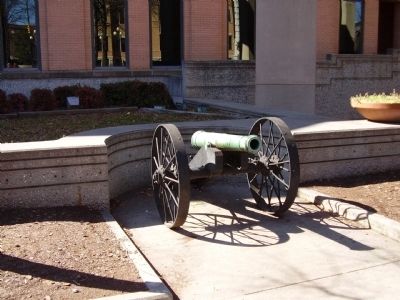
Photographed By Stanley and Terrie Howard, February 22, 2009
16. Courthouse Cannon (Old Reformer Cannon)
The old cannon that stands nearby likely pre-dates the Civil War. It may have been used by Confederate forces during the war. Update: Known as Old Reformer Brass Cannon. Believed to have been used in the Revolutionary War, it became known as "Old Reformer" in the Red Shirt Campaign of 1876. Brought to Anderson in 1814, it was placed on the town square in the early 1920s. (Source: Anderson Downtown Historic District National Register nomination form.)
The cannon has been moved and is now located at the Anderson County Museum.
— Submitted October 27, 2012, by Brian Scott of Anderson, South Carolina.
3. Anderson County Confederate Monument
The citizens of Anderson initiated an effort to raise money for a monument on "Decoration Day" in 1886. It would take sixteen years to complete the project. About 1891, the Anderson Home School, administered by Leonora C. "Nora" Hubbard, contributed $500. Hubbard, who began this great work and saw it through to the finish, helped organize the Ladies' Memorial Association of Anderson County in April 1895 and became its first president. This organization raised $2,500 for the monument by giving suppers, baby showers, silver teas, and cake walks. The monument design committee consisted of Nora Hubbard; Mrs. Bleckley and Ditma Gilmer from the Memorial Association; Mrs. C.S. Sullivan from the Robert E. Lee Chapter of the U.D.C.; Milledge L. Bonham, Anderson Lawyer and son of the Confederate General; and J.F. Clinkscales, representing the veterans. Clinkscales was formerly a sergeant in the group of men who initially formed Company C, 4th S.C. Volunteer Regiment; later, Company E, 13th S.C. Battalion; and finally, Companies I and K of the Hampton Legion. The committee commissioned Oscar Hammond of Greenville to sculpt the marble monument and William A. Todd to engrave the inscriptions. The Georgia Marble Works donated the foundation stone. The monument is made of Tennessee gray marble with a triple base, two dies and fourteen small blocks alternating rough and smooth marble. The marble figure of the Confederate soldier is seven feet, six inches tall. Originally an iron railing encircled the monument.
The thirty-five foot monument was dedicated on January 18, 1902, before thousands of spectators, including 150 Confederate veterans. The Clemson Band opened the day with Maryland, My Maryland. United Confederate Veterans General M.L. Bonham was Master of Ceremonies. Reverend J.D. Chapman, pastor of the First Baptist Church, gave the invocation. The next speaker was Mayor George F. Tolly, formerly a private in the Palmetto Riflemen, Company C, Palmetto Sharpshooters. Next, Mrs. S. Bleckley, vice president of the Confederate Memorial Association, read a paper describing the history of the monument. She was followed by Thomas W. Carwile of Edgefield, who had enlisted as a private in the Edgefield Rifles, Company D, 14th S.C. Volunteer Regiment. Carwile rose from private to captain for conspicuous gallantry displayed at the battle of Fraysers Farm. He commanded Company A of the 14th Regiment throughout the remainder of the war. James Armstrong, Jr., the "Irish Orator" of Charleston, delivered a fine speech bubbling over with Irish wit. Aunt Cora then sung the Conquered Banner, upon which Armstrong lowered his head to his desk and cried. Colonel S.W. Wilkes of Atlanta spoke last. His father, Adjutant Samuel M. Wilkes of the 4th S.C. Volunteers, was killed in the war. Nora Hubbard, who had done more than anyone else toward raising the monument, pulled the string to unveil the monument. The string broke, and a young man had to climb the monument to release the veil. The band played Taps and the crowd dispersed.
The monument remains in its original location on the western side of the old public square across the street from the old Anderson County Courthouse. The poems on the north and south faces are from Father Ryan's poem The Conquered Banner. (Source: A Guide to Confederate Monuments in South Carolina: "Passing the Silent Cup" by Robert S. Seigler, 1997, pg. 58.)
— Submitted February 28, 2009, by Brian Scott of Anderson, South Carolina.
4. Our Confederate Dead, (sculpture)
• Artist: Unknown, sculptor.
• Southern Monument Company, contractor.
• Title: Our Confederate Dead, (sculpture).
• Dates: Dedicated 1901.
• Medium: Sculpture: Tennessee marble; Base: marble.
• Dimensions: Sculpture: approx. 33 x 4 1/2 x 4 1/2 ft.; Base: approx. 3 x 8 x 8 ft.
• Surveyed 1993 September. Well maintained.
• Smithsonian American Art Museum Control Number
• Inventory of American Sculpture SC000008
— Submitted March 15, 2009, by Mike Stroud of Bluffton, South Carolina.
5. Major William Wirt Humphreys - Model for the Sculpture Atop the Monument
Major William Wirt Humphreys was a prominent citizen of Anderson, and a true son of South Carolina, a man of whom it can be truthfully said that no braver officer or more gallant soldier served on the Confederate side during the war, and no man enjoyed a wider popularity in the community in which he resided.
He was born in Anderson County, S.C., on October 30, 1837, being the son of Rev. David Humphreys, a Presbyterian clergyman, and Rebecca (Cunningham) Humphreys, both of whom were natives of South Carolina.
Major Humphreys was reared in Anderson County and received his collegiate education at Centre College, of Danville, Ky., from which he graduated in 1857. He then pursued the study of law and was admitted to the bar in 1860.
He located in Anderson and had barely entered upon the practice of his profession when the war broke out. At the first call for troops he volunteered and helped to organize Company B, Fourth South Carolina regiment, of which he was elected first lieutenant. He served with it twelve months, three as first lieutenant and nine as captain, having been promoted to the captaincy in May, 1861, at Columbia, to succeed James H. Whitener, who had been promoted to major.
He carried his company to Virginia and commanded it in the battles of First Manassas, Williamsburg, Seven Pines, Gaines' Mill, and Frayser's Farm. He was seriously wounded at the latter place by a ball that struck him full in the breast and which rendered him unfit for duty for several months and came near costing him his life. When he became able to re-enter active service, he was promoted major of the Palmetto Sharpshooters.
Joining his regiment at Fredericksburg, he served with distinction as its major until the close of the war, taking part in the campaigns of Suffolk, Va., and Knoxville, Tenn., the battles of Will's Valley, Wilderness, Spottsylvania, Second Cold Harbor, Bermuda Hundred, Fort Harrison, and the siege of Petersburg. His command was ordered to Richmond, and left Petersburg the day before the explosion of the mine under the fort which it had just vacated, thus escaping heavy casualties on the day of the battle of the Crater.
He received a slight wound at Spottsylvania Court House, but aside from this the last three years of his career as a soldier were passed without injury. He was a brave soldier and enjoyed the love and confidence of his men. It seemed that when he was in command his men knew no fear and thought of nothing but to go forward and follow his gallant leadership. By reason of his peculiar fitness as a leader of men he was almost always in command of the pickets and of the skirmish line, and as such he never failed to do his whole duty.
As a citizen Major Humphreys took high rank in Anderson, after the war, being repeatedly elected to positions of honor and trust, and his success as a lawyer and politician was as pronounced and decisive as his career as a soldier was brilliant. He was elected commissioner in equity in 1865, holding the office until it was abolished in 1868, when he was elected probate judge. He held that office successively until 1882, declining a re-election.
He then became president of the Savannah Valley railroad, in the promotion and construction of which he had been a prime mover and leading spirit. He was intendant of the town in 1878, and made a good mayor, and in the same year was appointed brigadier-general of militia, and in 1880 major-general.
Major Humphreys was married February 27, 1868, to Miss Anna Josephine McCully, of Anderson. Their marriage resulted in the birth of five children, two sons and three daughters. Major Humphreys died on October 6, 1893. The life of Major Humphreys, both military and civil, was exemplary throughout and is well worth the emulation of youth.
It is of little know fact that a likeness of W.W. Humphreys was used for the soldier atop the Anderson, S.C. Confederate Monument. His likeness was chosen as a lasting tribute to a gallant and honored soldier.
Confederate Military History: Capers, Ellison; South Carolina, edited by Clement Anselm Evans.
Jake O. Phillips
Camp 1428 SCV
Palmetto Sharpshooters
Anderson, S.C.
— Submitted December 12, 2010, by Jake O. Phillips of Anderson, S.c..
6. Monument description
• Confederate soldier on a tall square shaft banded with rustication.
• Bottom of each side has a pediment over a blind arch with relief carvings.
• A square base with text on each side rests on 3 steps.
• Uniformed soldier stands arms crossed, legs apart, rifle leans on proper left leg, its barrel in proper right hand. Belt, sword proper left hip, canteen other hip, feather (?) proper left hat.
• East/front arch: laurel wreath, crossed rifles, sword, canteen, bag.
• West arch: wheel, cannon balls, crossed cannon wads, flag.
• North pediment: tree; arch: crossed swords, laurel wreath.
• South pediment: laurel wreath, flag, dates 61-65; arch: anchor, ship's wheel.
• On north side of base, a flag is carved above the inscription.
— Submitted June 20, 2012.
Credits. This page was last revised on September 9, 2020. It was originally submitted on August 24, 2008, by Brian Scott of Anderson, South Carolina. This page has been viewed 13,560 times since then and 247 times this year. Last updated on September 6, 2020, by Bradley Owen of Morgantown, West Virginia. Photos: 1, 2, 3, 4, 5, 6, 7, 8. submitted on August 24, 2008, by Brian Scott of Anderson, South Carolina. 9. submitted on September 15, 2010, by Brian Scott of Anderson, South Carolina. 10, 11. submitted on June 14, 2009, by Brian Scott of Anderson, South Carolina. 12. submitted on September 15, 2010, by Brian Scott of Anderson, South Carolina. 13. submitted on September 16, 2010, by Brian Scott of Anderson, South Carolina. 14. submitted on October 27, 2012, by Brian Scott of Anderson, South Carolina. 15. submitted on June 20, 2012, by Mike Stroud of Bluffton, South Carolina. 16. submitted on March 3, 2009, by Stanley and Terrie Howard of Greer, South Carolina. • Bernard Fisher was the editor who published this page.
